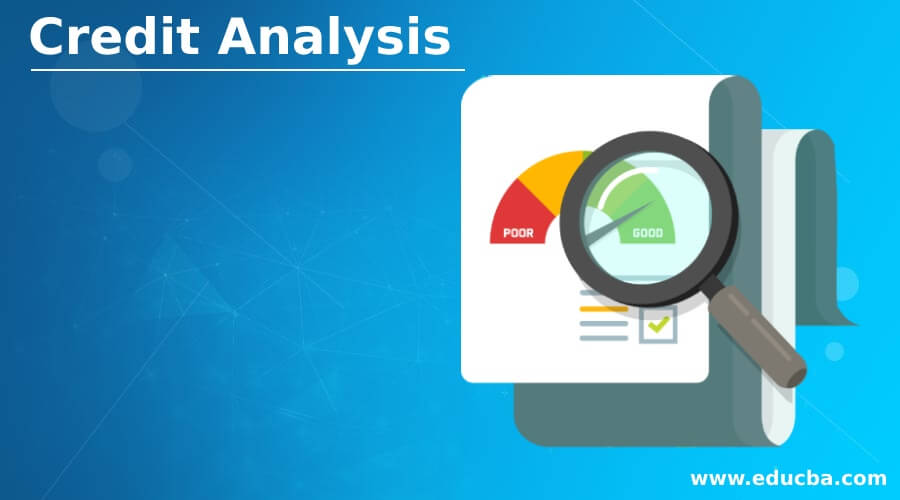
Definition of Credit Analysis
Credit analysis is a process in which an investor or bond portfolio manager calculates a company’s creditworthiness or other debt issuing entities. It helps the investor and bond portfolio manager measure the risk of investing in companies or other debt issuing entities.
Explanation
It is a process in which a lender analyzes borrowers to know their creditworthiness and the risks involved in extending credit to them. The credit analysis process comprises various techniques, namely cash flow analysis, trend analysis, risk analysis, ratio analysis, etc. All these analyses are done to determine the risk associats with investing and the loss the lender can suffer.
How Does Credit Analysis Work?
It is a lengthy process that could take a few weeks to a whole month. The process of credit analysis involves several stages, and the following are the several key stages of credit analysis:
- Information Collection: It is the first stage of the credit analysis process, and in this stage, an applicant’s credit history is checked by going through information such as repayment records, financial solvency, and transaction records with the banks. The lender also collects information about the purpose of loans and information regarding collateral for the loan.
- Information Analysis: In the second stage, the checking process verifies whether the borrower’s provided information collected in the first stage is accurate.
- Approval or Rejection: The last stage of the credit analysis process. In this stage, decisions are made by the lender after proper analysis of provides information as to whether to approve or reject the loan depending upon the level of risk.
Example of Credit Analysis
The credit analysis process can be understood better by taking an example of a financial ratio’s debt service coverage ratio used in the credit analysis process. The debt service coverage ratio measures the cash flow available to the borrower to pay the debt. The DSCR below 1 indicates negative cash flow, and the DSCR above 1 shows positive cash flow.
Credit Analysis Ratios
Numerous ratios are used in the process of credit analysis for decision making. The important ratios are discussed below:
- Liquid Ratios: Liquid ratios deal with a company’s ability to repay its expenses, creditors, and other short-term obligations.
- Solvability Ratios: Solvability ratios deal with a company’s balance sheet items.
- Solvency Ratios: The solvency ratio deal with the company’s ability to repay its long-term debt. If the ratio is not well enough, then there are chances that the business solvency is badly affected in the long run.
- Profitable Ratios: Profitable ratios show the company’s potential to earn profits.
- Efficiency Ratios: Efficiency ratios show the company’s ability to earn and how they control its expenses.
- Cash Flow Analysis: The cash flow analysis shows a fair picture of the cash flow in the business.
- Collateral Analysis: The security provided against the loan should have the qualities of stability, transferability, and marketability.
- SWOT Analysis: The SWOT analysis is done to arrange the expectation and reality with the condition of the market.
How Does a Bank Do Credit Analysis?
Banks carry out credit analysis by evaluating loan applications based on their merits. Banks go through every individual or entity’s creditworthiness to check the level of risk involved in granting the loan. They check through the documents and information to gather enough data for analysis. The level of risk that entails a loan application depends on document analysis.
Individuals with less risk are more likely to get their loan than individuals with a high level of risk.
5 C’s of Credit Analysis
- Character: It is the first thing that the lender notices about a borrower. It somehow creates an impact on lenders, which helps them to decide whether to approve a loan or not.
- Capacity: The most important factor to consider while granting a loan is showing the borrower’s ability to repay the debt. The assessment of the capacity of the borrower helps the lender to calculate whether the borrower can repay the debt or not.
- Capital: Capital is the money the borrower invests using the business’s assets. It shows the commitment of the borrower and how much risk the borrower will face if the business fails.
- Collateral: It is the security against the loan amount the borrower provides to cover up the loan amount if the borrower fails to repay in the given time.
- Conditions: Condition refers to the purpose of the sanctioned loan; it could be working capital, inventory, purchase of equipment, or a long-term investment.
Uses of Credit Analysis
- It is useful for creditors as it helps them to determine the borrower’s ability to repay the debt.
- It is useful for investors as it helps them to determine a corporation’s financial stability.
- This helps corporations to fulfill their need for capital by which they can expand their business.
Why is Credit Analysis Important?
It is beneficial for banks, corporations, investors, etc. As for the expansion of the business, corporations need capital that can be fulfilled by issuing bonds, shares, or by taking a loan. From the lender’s point of view, it is essential to have some sort of safety and surety against the loan being granted. For this, the credit analysis helps both the corporation and the lender as it will provide surety to the lender by providing the corporation’s creditworthiness, and the lender can invest the money depending upon the level of risk.
Conclusion
It is a process that provides information about the borrower’s creditworthiness, which helps the lender decide whether to provide a loan by keeping in mind the borrower’s past, present and future situations.
Recommended Articles
This is a guide to Credit Analysis. Here we also discuss the definition and how does credit analysis work? Along with uses and examples. You may also have a look at the following articles to learn more –

